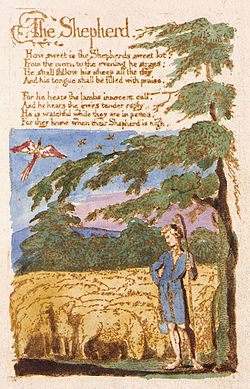
The Shepherd is a poem from William Blake's Songs of Innocence (1784). This collection of songs was published individually four times before it was combined with the Songs of Experience for 12 editions which created the joint collection Songs of Innocence and of Experience (1794). Blake produced all of the illuminated printings himself beginning in 1789. Each publication of the songs have the plates in a different order, and sixteen other plates were published posthumously[2]
Poem
editThe Shepherd
How sweet is the Shepherd's sweet lot!
From the morn to the evening he strays;
He shall follow his sheep all the day,
And his tongue shall be filled with praise.
For he hears the lamb's innocent call,
And he hears the ewe's tender reply;
He is watchful while they are in peace,
For they know when their Shepherd is nigh.
Critical Analysis
editThis poem is one of the three pastoral poems in Songs of Innocence, the other two being The Lamb and Spring.[3]This poem is written from the Piper's perspective. This can be seen in the repetition of the word 'sweet' in the first line which the Piper uses in the other poems of his narration.[4] The Little Boy Full of Joy that is depicted in Spring, grows into the shepherd of The Lamb, and then completes his journey through life as The Shepherd in this poem.[3]In the first stanza, The Shepherd is full of joy which mirrors the innocent nature of this collection of poems. In the second stanza, The Shepherd is presented as a caring and protective force over his herd. This can be seen in his listening for the call and reply of the ewe and lamb in the second stanza.[4] Readers from Blake's time would have found it odd that The Shepherd was following his herd.[5] Blake allows the voice of the poem to speak for itself rather than revealing a firm interpretation.[5] The Shepherd's relationship to his flock is further explored in the final lines of the poem. When he is present, the herd remains calm and peaceful.
There are also religious connotations in this poem. Psalm 23 depicts God as a shepherd of mankind.[4] The capitalization of the word 'Shepherd' in the first and last lines furthers the idea that the Shepherd is a symbol of God.[4] In addition to this, Jesus is also referred to in the bible as the Lamb of God. The usage of biblical terminology allows the reader to view both the sheep and The Shepherd as protectors of each other.[4] The Shepherd watches over his herd with delight as God watches over his people. Reversed, Jesus - represented as a lamb - does not lead mankind - The Shepherd - astray.[4]
Illustration
editThe Shepherd in the illustration is standing underneath a vine-wrapped tree surrounded by his herd of sheep. This dove underneath the poem mimics the dove found on the introduction plate. [4] Typically a symbol of peace, the dove enables the reader to absorb the peaceful setting that is typical of a pastoral poem.[3] Depending on the version, the sun appears to either be rising or setting.[4] The rising sun gives the impression of new beginnings that is consistent with innocence while the setting sun encourages the reader to view the poem as the end of a journey through innocence and onto experience.[3]
External links
editReferences
edit- ^ "Songs of Innocence, copy B, object 4 (Bentley 5, Erdman 5, Keynes 5) "The Shepherd"". William Blake Archive. Retrieved January 17, 2014.
{{cite web}}: Unknown parameter|editors=ignored (|editor=suggested) (help) - ^ Eaves, Morris; Essick, Robert N.; Viscomi, Joseph. "Songs of Innocence". The William Blake Archive. Retrieved 29 March 2015.
- ^ a b c d Gardner [15-21]
- ^ a b c d e f g h Leader [75-79]
- ^ a b Glen [3-5]
Sources
edit- Gardner, Stanley (1986). Blake's Innocence and Experience retraced. London: Athlone Press. ISBN 0-312-08354-8.
- Leader, Zachary (1981). Reading Blake's Songs. Boston: Routledge & Kegan Paul. ISBN 0-7100-0635-7.
- Glen, Heather (1983). Vision and Disenchantment:Blake's Songs and Wordsworth's Lyrical Ballads. Cambridge University Press. ISBN 9780521271981.